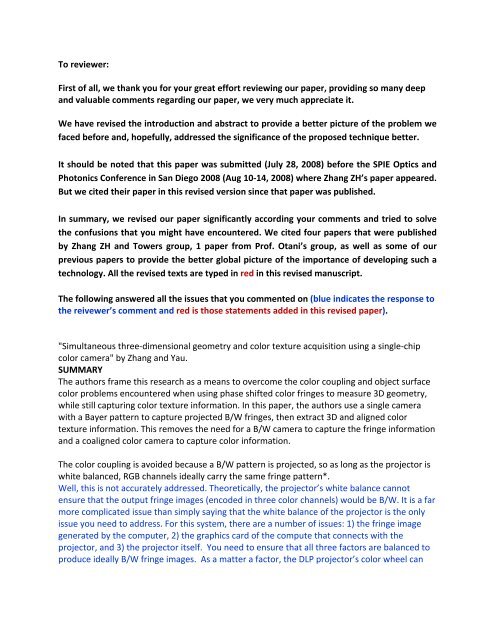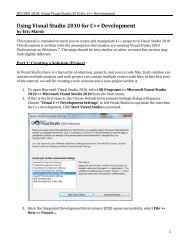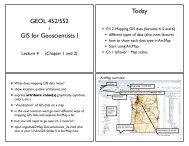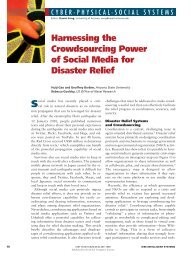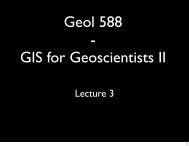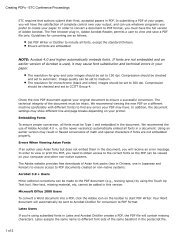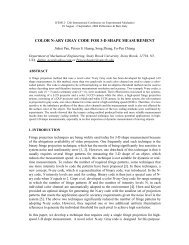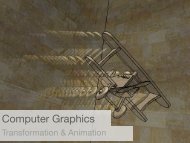First of all, we thank you for your great effort reviewing our paper ...
First of all, we thank you for your great effort reviewing our paper ...
First of all, we thank you for your great effort reviewing our paper ...
- No tags were found...
You also want an ePaper? Increase the reach of your titles
YUMPU automatically turns print PDFs into web optimized ePapers that Google loves.
For instance, a recent <strong>paper</strong> [1] Zhang ZH, et.al can also simultaneously capture both 3D andcolor texture in<strong>for</strong>mation using readily available hardware [1]. They claim f<strong>our</strong> images arerequired <strong>for</strong> a RGB f<strong>our</strong> phase shifted method, or a single image <strong>for</strong> a FFT method. Theirsolution to the color bleeding problem ho<strong>we</strong>ver requires a model <strong>of</strong> the color bleeding andusing nonlinear regression to find the color modulation and phase in<strong>for</strong>mation.We added in Section 1, on page 4 to cite Zhang ZH and his collaborators f<strong>our</strong> <strong>paper</strong>s related tocolor problem:Zhang et al proposed a technique to <strong>all</strong>eviate the color coupling problems <strong>of</strong> the system [11, 12,13]. For this technique, it utilized a 3x3 matrix to represent the color coupling effect <strong>of</strong> thesystem, which was a pretty nice approach to deal with the color coupling problem. Ho<strong>we</strong>ver,calibrating the color coupling matrix could be a complicated issue since each pixel might haveslightly different responses if the lens chromatic aberration is considered. In 2008, theyproposed another approach to deal with color bleeding (or coupling) [14]. For this approach,f<strong>our</strong> fringe images are required (even though they claimed that a single image using a FFTmethod might be feasible, which have not been proven yet). Ho<strong>we</strong>ver, this technique requiresa model <strong>of</strong> the color bleeding that uses nonlinear regression to find the color modulation andphase in<strong>for</strong>mation. All above mentioned <strong>paper</strong>s by Zhang and his collaborators tried to solvethe problem <strong>of</strong> measuring color and geometry simultaneously by utilizing 3‐CCD color cameras.Ho<strong>we</strong>ver, none <strong>of</strong> them is suitable <strong>for</strong> real‐time 3D shape measurement since more than 3fringe images are utilized to deal with color related issues. In general, <strong>all</strong> the techniques usingcolor fringe images suffer the problem: they may not measure the surface pr<strong>of</strong>ile properly. Forexample, <strong>for</strong> a red object, the green and blue light will be absorbed, and the in<strong>for</strong>mationcarried on by these color fringes will be lost.Another <strong>of</strong> Zhang ZH,et.al's recent publications [2] avoids the color coupling problem byprojecting RGB channels separately. Their computations <strong>for</strong> computing phase and color appearto be a f<strong>our</strong> phase shifted fringe version <strong>of</strong> what appears in this <strong>paper</strong> by Zhang S. They pick theRGB channel with the largest modulation to compute the phase from, and use the RGBchannels to compute the color texture. T<strong>we</strong>lve RGB frames are needed to acquire the data(compared to three RGB frames <strong>for</strong> Zhang S and Yau). Zhang ZH's <strong>paper</strong> also shows there isinterest in this problem and gives further support to why this <strong>paper</strong> by Zhang S and Yau shouldlikewise be published.Same as aboveCONSThe <strong>paper</strong> does not seem to emphasize or adequately explain the principles and advantages <strong>of</strong>the main technique used to overcome the color bleeding and object color problems. The overemphasison using a Bayer color filter distracts from key points <strong>of</strong> the <strong>paper</strong>, especi<strong>all</strong>yconsidering a 3‐CCD camera should achieve the same results. The key points to solve the colorproblems should be presented, then the addition <strong>of</strong> the Bayer filter discussed.
3‐CCD camera could be used, but might result in unnecessary problems besides the cost <strong>of</strong> thesystem, which will be explained in detail in the following context. The success <strong>of</strong> this elegantapproach relies heavily on this Bayer filtered technology. As a matter a fact, this technology washighly appreciated by colleagues in both industry and academia. We have applied patent <strong>for</strong>this technology even though it looks like naïve to many fellows in the metrology field. Industries(esp. entertainment) are looking <strong>for</strong> this technology <strong>for</strong> many years, that’s why <strong>we</strong> areinterested in developing such a technology, albeit it seems irrelevant to metrology folks.Structural problems in the <strong>paper</strong> need to be addressed, so the <strong>paper</strong> is better organized. Many<strong>of</strong> the advantages and disadvantages <strong>of</strong> the <strong>paper</strong> are discussed in relation to a Bayer colorcamera compared to a B/W camera used <strong>for</strong> 3D capture (without texture). Since this <strong>paper</strong> isabout the simultaneous 3D geometry/texture acquisition, the advantages/disadvantages shouldbe in comparison to similar systems. Additional analysis is needed <strong>for</strong> white balance, chromaticaberration, and texture/geometry accuracy. Despite <strong>of</strong> the claims <strong>of</strong> being novel, very little newis added in terms <strong>of</strong> technique, analysis, or setup from previous works by the author. The sm<strong>all</strong>change that is made from previous works does ho<strong>we</strong>ver lead to a compelling result. Either the<strong>paper</strong> should be converted to a Letter, or additional (necessary) analysis should be per<strong>for</strong>med<strong>for</strong> the work to be <strong>of</strong> significance <strong>for</strong> a <strong>paper</strong>.Well, this is c<strong>all</strong>ed engineering. Some slight problems could prevent the technology fromadvancing. Some seemingly simple and naïve solution might be the killer <strong>of</strong> those complicatedsolutions, and might provide better results by playing some little tricks. I agree that the camerais a common technology, the projector is a common technology, the structured light techniqueis not new, not to mention about phase‐shifting. Ho<strong>we</strong>ver, there are still a lot <strong>of</strong> research needsto be conducted to make it applicable to other fields, to make it acceptable to industries as <strong>we</strong>llas other scientific research fields. There<strong>for</strong>e, the technology proposed in this <strong>paper</strong> indeedsolved a pretty big problem existing in many years, if <strong>you</strong> are familiar with industries and otherrelated fields. Besides, <strong>we</strong> have been frequently requested to solve this problem since 2004 (4years ago), but could not successfully find a nice solution until <strong>we</strong> came out this idea.• There is a typo in the abstract: "The same set <strong>of</strong> fringe images can be SUED...". Should be"USED".Sorry <strong>for</strong> this typo error and <strong>thank</strong>s <strong>for</strong> picking it up.• The <strong>paper</strong>'s structure could be changed a bit.Section 2. Principle SectionThe Bayer pattern is not essential to the ability <strong>of</strong> the algorithm to avoid the effects <strong>of</strong> colorbleeding and object color effects. A 3‐CCD camera could be used and achieve the simultaneous3D geometry and texture capture. Putting the Bayer pattern first in the Principle sectionoveremphasizes its importance to the technique, and in some ways can add to reader confusion.
The phase shifting algorithm should probably come first in the Principle Section. The mostimportant step and one <strong>of</strong> the keys to this <strong>paper</strong>, <strong>of</strong> using the average intensity <strong>for</strong> the texturesince it doesn't have fringe stripes, is only given one sentence and not emphasized norexpanded upon. Similarly, the other key step <strong>of</strong> using B/W fringes to avoid color bleedingproblems isn't mentioned until Section 3 System Setup, when it should be in the Principlesection. Again, it is given one sentence in passing without much explanation.We stated the B/W fringe, Bayer filter, etc in Introduction section <strong>for</strong> <strong>our</strong> first version. In thisrevised version, <strong>we</strong> re‐stated the detailed explanations in this section.The following statements <strong>we</strong>re added in Subsection 2.2, on page 10, phase‐shifting algorithm:For this research the B/W fringe is used to avoid the color related problems. If the color wheel<strong>of</strong> a DLP projector is removed, as <strong>our</strong> previous system [1], the B/W fringe images will beprojected directly. Ho<strong>we</strong>ver, <strong>for</strong> an ordinary color projector, in order to generate the ideal B/Wfringe images, the color calibration procedure is required to balance three color channels <strong>of</strong> thewhole system. For this research, since the precisely ide<strong>all</strong>y balanced color channels are notrequired to successfully per<strong>for</strong>m the measurement. We simplify generate fringe images withR=G=B, and adjust the color balance <strong>of</strong> the projector manu<strong>all</strong>y and visu<strong>all</strong>y. Because the surfacecolor affects each B/W fringe image projected by the projector at exactly the same manner, andthe captured fringe images used <strong>for</strong> phase calculation are also affected by the surface color inthe same manner, there<strong>for</strong>e, the problem induced by the surface color <strong>for</strong> each point isavoided. Three successively projected fringe images can be used to calculate the phase using Eq.(4). At the same time, by employing Eq. (5), the same set <strong>of</strong> fringe images can also be used togenerate a B/W texture image with Bayer mosaic patterns, which can be converted to colorimage using a demosaicing algorithm. There<strong>for</strong>e, the same set <strong>of</strong> fringe images cansimultaneously retrieve the 3‐D geometry and the color in<strong>for</strong>mation.The calibration should probably be in Section 3 System Setup, because it isn't key to theoperating principle. It would go <strong>we</strong>ll after paragraph on projector color balance.I don’t agree with this, since the Bayer technology is very important <strong>for</strong> the success <strong>of</strong> thisproposed technique. It should be addressed be<strong>for</strong>e the phase‐shifting technology since it isused when <strong>we</strong> explain the 3D shape measurement technique in the phase‐shifting section.Section 4 Experiments and Section 5 DiscussionSection 4 contains both the experiment and discusses the results <strong>of</strong> the experiments.Likewise, a new experiment is shown in the Discussion Section to show the local intensityvariation <strong>of</strong> the single ship camera when imaging a white card. It might be better to put thewhite card experiment in the Experiment section, and in Section 5 do more in depth discussion<strong>of</strong> the experiments and how their results relate and rein<strong>for</strong>ce each other, rather than just listadvantages and disadvantages.We believe that showing local noise problem in the discussion section is more proper since it isnot the key point <strong>of</strong> the <strong>paper</strong>, but just a possible drawback <strong>of</strong> the technique. As a matter a
factor, some (more expensive) single‐chip color camera <strong>all</strong>ows adjust each color pixels’ gainindividu<strong>all</strong>y, and this type <strong>of</strong> problem might not be so severe. This feature is not in <strong>our</strong> currentcheap camera.Instead, to clarify this confusion, <strong>we</strong> added the following statement in the discussion session:Section 5, on page 16It should be noted that <strong>for</strong> <strong>our</strong> very low cost camera, the local noise is significant. Ho<strong>we</strong>ver,there are single‐chip (more expensive) color cameras <strong>all</strong>owing <strong>for</strong> adjusting gain <strong>for</strong> eachindividual color pixels where the local intensity variations will not be as significant as the one<strong>we</strong> tested.ReferencesI would suggest reading, referencing, and compare/contrasting with Zhang, To<strong>we</strong>rs, and To<strong>we</strong>rs<strong>paper</strong>s, as they seem to be on a par<strong>all</strong>el track to Zhang S and collaborators' various works albeitusing a 4 phase shift technique and their multifrequency selection. Zhang Z's <strong>paper</strong>'s doreference and discuss Zhang, Huang and collaborators.Refer to Pros. above, <strong>we</strong> extensively cited <strong>all</strong> their <strong>paper</strong>s to do color related issues.I don’t know which <strong>paper</strong> they addressed <strong>our</strong> technique [3]. As far as I knew, they have notaddressed <strong>our</strong> technique by utilizing two cameras to solve the color issue in any <strong>of</strong> their <strong>paper</strong>s.I guess the revie<strong>we</strong>r might mistakenly regard somebody else’s <strong>paper</strong>s as <strong>our</strong>s.• White balance is assumed in the setup section. How does the color accuracy and phaseestimation vary if the projector is not white balanced? In this case, wouldn't it only affect thethe color texture, not the phase? Each color filtered pixel (either 3‐CCD or Bayer) sees <strong>all</strong> threephase stepped sinusoids in the same color and is affected by the object color in the same way.It seems projector color balance does not affect the phase, even if the camera's color filters donot match the projector's. The color texture may not be white balanced, but that can be doneafterwards in s<strong>of</strong>tware. If true, these seem like advantages to be emphasized.This is not the case, un<strong>for</strong>tunately. Let’s give an example, if the projector is severely distorted,e.g., only projects red spectra light, and if the object surface is blue, there will be no lightreflected, there<strong>for</strong>e, the measurement cannot be per<strong>for</strong>med.• Calibration is done on one color. Since B/W fringes are projected, but color components arecaptured, how does chromatic aberrations in the projector and camera affect color and 3Dgeometry estimates? Each color <strong>of</strong> the fringe pattern will have a slightly different spatialfrequency, since red bends more than blue and green. See reference [2]. Can this be resolvedby calibrating on each <strong>of</strong> the 3 colors?Well, this is not an obvious issue <strong>for</strong> <strong>our</strong> system as long as the color channels are not severelyunbalanced. Unlike the technique introduced in reference [2], <strong>our</strong> proposed technique is notsignificantly affected by this slight unbalanced problem, since the camera white balance is
calibrated under the same lighting condition as the measurement. As long as the projector lightdoes not significantly change during the calibration process and the measurement process, thisissue will not be problematic <strong>for</strong> <strong>our</strong> system.With the Bayer pattern, the phase estimates may be impacted more than if it was done with a3‐CCD camera, since the Bayer takes alternating red,blue,green phase estimates (point by point)to make a single contiguous wrapped phase estimate, where as the 3‐CCD would have threecontiguous wrapped phase estimates (one <strong>for</strong> each color).It is true that using 3‐CCD camera has its advantages, while its drawbacks are obvious: 1) moreexpensive, 2) phase calculation becomes problematic since it is extremely difficult to guaranteethat 3 CCDs in the color cameras and 100% accurately aligned pixel by pixel. The misalignmentcould cause the phase shift error, which might be significant if the camera is at low cost. WhileBayer filtered sensor does not have the alignment issue, and cheap at the same time.We added the following statement in Section 1, on page 6:In this research, <strong>we</strong> utilized a single‐chip color camera instead <strong>of</strong> a 3‐CCD camera. The reasonsare: 1) 3‐CCD cameras are gener<strong>all</strong>y more expensive comparing with single‐sensor cameras; 2)The phase calculation might be problematic since it is extremely difficult to guarantee that 3CCDs in the color cameras are 100% accurately aligned pixel by pixel. This misalignment cancause the phase shift error, which might be significant if the camera is at low cost; and 3) theysuffers the same light loss as the single‐chip color cameras since each sensor only capturespartial spectra <strong>of</strong> the light. Of c<strong>our</strong>se, 3‐CCD cameras might provide better image quality thansingle‐chip cameras because local noise is sm<strong>all</strong>er.• The images look hastily captured with barrel distortion, uneven lighting, crooked. This mayshow robustness (although it isn't mentioned in the <strong>paper</strong>), but it looks untidy.Bear in mind that the camera (Mightex MCN‐C013‐U) <strong>we</strong> used is a 190 US $ CMOS camera asspecified in <strong>our</strong> system setup. The projector (Optoma EP739) <strong>we</strong> used is only $700 f<strong>our</strong> yearsago.We added the price <strong>of</strong> the camera and the projector in this revised version, in Section 4, onpage 12, experiments.Be<strong>for</strong>e <strong>we</strong> show the experimental results, <strong>we</strong> want to emphasize that that the camera <strong>we</strong> usedis a CMOS camera at very low cost US $190, and the projector is also very cheap, which is US$700 f<strong>our</strong> years ago. The noise <strong>of</strong> the system can be significantly reduced by utilizing a betterCCD camera and a better projector. The key <strong>of</strong> the experimental results is to demonstrate thefeasibility <strong>of</strong> this proposed technique.• There are artifacts in the 3D data, mostly where the image intensity is low. The textureappears in the 3D data. Although this is somewhat expected, it is not discussed in the <strong>paper</strong>. Italso doesn't appear in the rendered 3D object when vie<strong>we</strong>d <strong>of</strong>f axis. It looks significant enoughto affect the mesh, and widespread that it wouldn't be smoothed out by the gaussian filter. Can
<strong>you</strong> show noisy 3D data and a smoothed one so <strong>we</strong> can get a sense <strong>of</strong> how much smoothing isoccuring, or whether a Median filter might be better?The noises are mostly caused by the sensors (camera and projector) used, as addressed above.Only 3x3 Gaussian filter is used, the noise is not reduced drastic<strong>all</strong>y. Ho<strong>we</strong>ver, un<strong>for</strong>tunately,median filter will not drastic<strong>all</strong>y reduce this type <strong>of</strong> noise due to its internal processing nature.A mean filter might produce better results, but mean filter is less extensively used because ithas some bad features <strong>for</strong> image processing.• Fig 4c, shows a cross section with +/‐1mm accuracy in z. The <strong>paper</strong> says this techniqueprovides absolute phase after calibration, so why does the figure show distances +/‐?How far away was the target? Is this typical accuracy? Although the phase extraction wasdiscussed in an earlier <strong>paper</strong>, no mention <strong>of</strong> the accuracy was given in this <strong>paper</strong>. Since this<strong>paper</strong> is concerned with simultaneous extraction <strong>of</strong> 3D geometry and color texture, how doesthe accuracy <strong>of</strong> one affect the other? Is it ever better to use two cameras instead <strong>of</strong> one?The accuracy is determined by the calibration accuracy, the system sensor noise, and themeasurement condition. I guess this is not the key issue that should be extensively addressed inthis <strong>paper</strong>. To ans<strong>we</strong>r <strong>you</strong>r curiosity, the +/‐ sign was the measurement error when the object isset at the xy plane <strong>of</strong> the coordinate system. The calibration accuracy is approximately RMS0.5mm <strong>for</strong> the measurement area <strong>of</strong> approximately 250mm(H) x 250 mm(W) x700 mm(D)range. The object was set approximately 1.5 meters away from the system <strong>for</strong> thismeasurement.Regarding <strong>you</strong>r last question, everyone has different opinion <strong>for</strong> using two cameras or just onecamera. Nothing is perfect in the world! You need to obtain something to scarifying somethingelse, right?The key <strong>of</strong> this <strong>paper</strong> is to obtain precisely (100%) aligned 3D geometry and color texture, whichhas been successfully demonstrated, <strong>we</strong> believe.• Page 13, "if this method is applied to <strong>our</strong> previous system[10], it can also do real‐time 3Dshape measurement with color texture" Page 14 Fast speed, also. More in<strong>for</strong>mation is needed,as readers may not be familiar with <strong>you</strong>r other research, even if its just "the previous systemprojected B/W fringes, used a B/W camera to capture fringe images, and a slow averagingcoaligned color camera to remove the fringes and capture texture images."Well, the reader needs to read <strong>our</strong> previous <strong>paper</strong>s. That’s why the references <strong>we</strong>re provided.Even though, <strong>we</strong> added one paragraph in Section 1, on page 3, to summarize <strong>our</strong> previous workand provide some background knowledge <strong>for</strong> solving this problem.Our research endeavors to develop techniques <strong>for</strong> real‐time 3‐D shape measurement. In <strong>our</strong>recently ef<strong>for</strong>ts, <strong>we</strong> have a developed real‐time 3D shape measurement system that canper<strong>for</strong>m simultaneous data acquisition, reconstruction and display at 30 frames/sec[1] byutilizing a fast three‐step phase‐shifting algorithm[2]. We recently developed techniques to do
eal‐time 3D absolute coordinate measurement by employing GPU techniques [3, 4]. In <strong>our</strong><strong>paper</strong> [1], <strong>we</strong> also addressed a problem to obtain color by utilizing an additional color camera.Ho<strong>we</strong>ver, obtaining precisely aligned geometry and color texture remains not very difficult.Over the past few years, <strong>we</strong> have been constantly requested to develop a simultaneousgeometry and color texture acquisition technique <strong>for</strong> <strong>our</strong> real time system. They <strong>all</strong> requiredthat the color texture should be precisely aligned with 3‐D geometry point by point <strong>for</strong> eachframe. In the meantime, the cost <strong>of</strong> the system should not be very much increased. In this<strong>paper</strong>, <strong>we</strong> propose such a technique that uses a single‐chip color camera to simultaneouslycapture the geometry and color texture simultaneously. The major advantages <strong>of</strong> this proposedtechnique are: 1) acquire 3D geometry and color texture simultaneously, 2) has the potential toimplement into <strong>our</strong> real‐time system, 3) acquire color texture that is precisely aligned with the3D geometry, and 4) Cost is not significantly increased.• Many <strong>of</strong> the advantages/disadvantages are compared to a B/W camera <strong>for</strong> 3D capture. Thepremise <strong>of</strong> this <strong>paper</strong> is that this is better than a B/W camera <strong>for</strong> 3D capture and a color camera<strong>for</strong> texture. The advantages/disadvantages should compare to the BW/color camera combo.I think I have addressed in this introduction section. No need to repeat again.Low cost. The B/W camera with or without the Bayer Filter costs the same. This argument is<strong>we</strong>ak. A better argument perhaps is with other systems, color bleeding can be prevented byreplacing color wheel <strong>of</strong> projector (expensive/difficult), multiple cameras. Others use 3 chipCCD (where as <strong>you</strong> use standard Bayer).Well, these arguments <strong>we</strong>re even <strong>we</strong>aker because the hardware costs <strong>of</strong> different systems aredifferent. Our argument is that <strong>we</strong> do not increase the hardware cost at <strong>all</strong> to obtainsimultaneous and precisely aligned COLOR texture as a BONUS.Longer Exposure. B/W vs color (Bayer?). This argument could use a bit more explanation. Yes,the color filter on each Bayer pixel filters out 2/3's <strong>of</strong> the light, but this technique could be usedon a 3‐CCD camera with dichroic filters in which case a majority <strong>of</strong> the light will be captured.Again, the discussion <strong>of</strong> the effects <strong>of</strong> using a Bayer pattern is interfering with making theadvantages <strong>of</strong> the main technique obvious. Many <strong>of</strong> the disadvantages appear to come fromusing a Bayer pattern, not from the technique itself. In fact, using a 3‐CCD camera would <strong>all</strong>owthe color fringe with the largest modulation to be used <strong>for</strong> phase computation (similar to ZhangZHs work [2]), and capture a full resolution texture that matched the resolution <strong>of</strong> the 3Dgeometry. The pixel to pixel intensity differences would be lo<strong>we</strong>r, which may lead to bettersignal to noise ratio (and less need <strong>for</strong> the Gaussian averaging to remove noise which mustlo<strong>we</strong>r resolution), and lead to better light collection.Are <strong>you</strong> only selling <strong>for</strong> Zhang ZH’s works? Just kidding! Besides the drawbacks <strong>of</strong> 3‐CCDcameras addressed previously, 3‐CCD cameras suffer the same type <strong>of</strong> light loss as Bayer filtercameras. Prism is usu<strong>all</strong>y used to separate the incoming light into three parts, red, green, andblue, which are then passed onto the sensor. There<strong>for</strong>e, only about 1/3 <strong>of</strong> the light <strong>for</strong> each
color channel is captured <strong>for</strong> a white light. Even though Zhang ZH’s <strong>paper</strong> did not notice thisproblem, but it was there un<strong>for</strong>tunately.The point by point phase estimation is needed since the Bayer pattern alternates bet<strong>we</strong>en red,blue and green, so there may be a significant intensity variation in a 2x2 grid which may affectan estimate based on neighboring points. If a 3‐CCD camera is used, there will be less intensityvariation (a white board will be an even color in red, green, blue), so this wouldn't be as much aproblem. The point by point phase estimation can be augmented with local variations to detectlarge gradients or discontinuities which affect phase wrapped systems.This is true to this sense, but the geometry measured would be problematic besides its morecost, as already addressed.In other words, most <strong>of</strong> the disadvantages <strong>of</strong> the techniques described in the <strong>paper</strong> are due to aBayer pattern being used instead <strong>of</strong> a 3‐CCD camera. The use <strong>of</strong> a Bayer pattern is usu<strong>all</strong>y just ainexpensive way to replace a 3‐CCD camera, since the colors are spati<strong>all</strong>y multiplexed. Althoughthe ability to use a Bayer pattern camera is advantageous in terms <strong>of</strong> cost , it in some wayconfuses the description and advantages <strong>of</strong> the main technique to solve the color problems byadding an additional (unncesssary) layer <strong>of</strong> color demultiplexing (which is <strong>we</strong>ll known) and theassociated problems with the Bayer pattern described above. I would suggest discussing thetechniques to solve the color problems without the Bayer pattern, then add the Bayer patternand discuss further advantages and disadvantages.The whole point <strong>of</strong> this <strong>paper</strong> yet: Low cost (no increase), simultaneous geometry and colortexture measurement, and possibly <strong>for</strong> real‐time 3D shape measurement. Of c<strong>our</strong>se, 3‐CCDcameras will work too although it might bring other problems.• The <strong>paper</strong> does not seem to emphasize the principle and advantages <strong>of</strong> the main techniqueused to overcome the color bleeding and object color problems; They are mentioned in onesentence in the principle section and in another sentence in the setup section. It would help thereader to describe how variations in color bleeding and object color do not affect the phase andcolor estimates, rather than just stating that with B/W fringes it isn't a problem. Similarly, thereis not much emphasis given to the limitations <strong>of</strong> this technique, such as when the fringes aren'tcolor balanced or the effects <strong>of</strong> chromatic aberration.Already done, in the introduction part, refer above.• Despite <strong>of</strong> the claims <strong>of</strong> being novel, very little new is added in terms <strong>of</strong> technique, analysis,or setup from previous works by the author. The use <strong>of</strong> color phase shifted fringes <strong>for</strong> singlepixel phase extraction and phase unwrapping have been previously published. The equationsand calibration techniques are from previous works. The Bayer filter and color deinterlacing(from the averaged image) are <strong>we</strong>ll known.
I am pretty sure that <strong>our</strong> <strong>paper</strong> provided an elegant solution <strong>for</strong> this problem instead <strong>of</strong> utilizingmultiple fringe images, or 3‐CCD camera, or color coupling matrix, etc. We have received <strong>great</strong>comments from the SPIE conference this year at San Diego. We believe many audiences <strong>we</strong>revery much impressed by this elegant solution, even though <strong>we</strong> may not be able to convince <strong>you</strong>that <strong>our</strong> <strong>paper</strong> is important.The main techniques <strong>of</strong> this <strong>paper</strong> used to remove the color bleeding and object color effectsand to capture the color texture are the use <strong>of</strong> B/W fringes and averaging the fringes toproduce a fringeless image. These ideas both mentioned in one <strong>of</strong> the author's (Zhang S)previous works "High‐resolution, real‐time three‐dimensional shape measurement" [3]. Itstates, "Color tolerance: Unlike those real time systems based on color‐coded structured lightmethods, this system uses B/W fringe images. There<strong>for</strong>e the object color does not affect themeasurement accuracy." " ...averaging the three fringe patterns washes out the fringes ...",although they use the camera's exposure time to do the averaging, rather than do it in s<strong>of</strong>tware.Also, "It should also be noted that <strong>we</strong> can also obtain a B/W image <strong>for</strong> the texture mapping byaveraging the three phase‐shifted fringes". One <strong>of</strong> the future works this <strong>paper</strong> suggested was tosimply replace the B/W camera with a color camera.The fact that a sm<strong>all</strong> change in the setup has produced the desired ability to capturesimultaneous 3D geometry and color texture is not lost on this revie<strong>we</strong>r. Ho<strong>we</strong>ver, with this inmind, the results should be either presented as a Letter (which I don't believe gives the endresult the proper exposure it deserves), or more in‐depth analysis should be per<strong>for</strong>med.I do recommend that this <strong>paper</strong> be published, but the <strong>paper</strong> needs to be revised with somestructural changes and additional analysis to present the work in its best light.In addition, <strong>we</strong> made the following changes in this <strong>paper</strong>:Abstract: on page 2, line 1, <strong>we</strong> addedand rapidlyAbstract: on page 2, line 3, <strong>we</strong> addedUsing a single color camera either reduces the measurement speed or drastic<strong>all</strong>y sacrifices themeasurement qualityAbstract: on page 2, line 11, <strong>we</strong> added:Since only three fringe images are required, this technique is suitable <strong>for</strong> real time 3‐D shapemeasurement.Section 1: page 3, line 3, <strong>we</strong> added:With recent advancements <strong>of</strong> real‐time 3‐D shape measurement technologies, theSection 1: page 3, line 3, <strong>we</strong> added:With recent advancements <strong>of</strong> real‐time 3‐D shape measurement technologies, theSection 5: page 15, 6 lines from bottom, <strong>we</strong> added:
It should be noted that even if a more expensive 3‐CCD color camera is used in such a system,the exposure time still needs to be significantly longer since only partial <strong>of</strong> the light is passedonto each individual sensor.I hope that <strong>our</strong> ef<strong>for</strong>t to revise this <strong>paper</strong> has already satisfied <strong>you</strong>r requirements. We re<strong>all</strong>yappreciate <strong>you</strong>r <strong>great</strong> ef<strong>for</strong>ts to providing such knowledgeable and deep comments on <strong>our</strong><strong>paper</strong>.References.1. Zhang ZH, To<strong>we</strong>rs CE, To<strong>we</strong>rs DP. Phase and Col<strong>our</strong> Calculation in Col<strong>our</strong> FringeProjection.J.Opt.A:Pure Appl.Opt. 9 (2007) S81‐S862. Zhang ZH, To<strong>we</strong>rs CE, To<strong>we</strong>rs DP. Shape and Col<strong>our</strong> Measurement <strong>of</strong> Col<strong>our</strong>ful Objects byFringe Projection. Proc. <strong>of</strong> SPIE vol 7063 (2008)3. Zhang S, Huang PS. High‐resolution, real‐time three‐dimensional shape measurement,Optical Engineering. 45(12) (2006)


